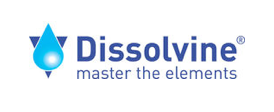Dissolvine®
Chelating Agents
The high-performance solution for metal ion control
Dissolvine®
Chelating Agents
The high-performance solution for metal ion control

Dissolvine® chelates can add or remove metal ions or alter metal ions properties in a controlled way in a wide range of applications. Our new Dissolvine® products meet future health, safety and environmental requirements today.
Dissolvine aminopolycarboxylate-based chelating agents are used to control metal ions in water-based systems. They are highly effective for controlling water hardness ions as well as for cleaning surfaces, descaling boilers, processing textiles and preventing scale formation.
Dissolvine chelating agents are an important tool for controlling metal ion reactivity and are used for reducing the detrimental effect of metal catalysts in peroxide cleaners and in pulp bleaching for paper manufacturing. Other applications include improving personal care formulations and stabilizing food products as well as pharmaceutical formulations.
Dissolvine chelating agents are also used extensively to enhance the chemical and physical properties of metal ions, ranging from metal plating, providing essential elements to growing plants and supplying iron for H2S gas scrubbing.

While classical aminopolycarboxylates (NTA, EDTA and DTPA, etc.) provide outstanding performance in terms of cost effectiveness and versatility, they may not always fulfill all customer needs regarding performance, properties and health, safety and environmental considerations.
Innovating and supplying high performing products with a low environmental impact is important to us. In our search for a product that delivers excellent chelating performance with readily biodegradable properties, we have introduced Dissolvine GLDA and MGDA, both chelating agents that have proven track records in many institutional and household cleaners.
Dissolvine product range
| Dissolvine® | Properties |
| EDTA | The most widely used, very strong cost-effective and general purpose chelating agent. |
| GLDA | The green and strong chelate in our product range. A safe and readily biodegradable chelating agent, that can be used as an alternative for NTA,EDTA, phosphates and phosphonates, especially in cleaning applications. |
| MGDA | A safe and readily biodegradable strong chelating agent, that can be used as alternative for NTA, EDTA, phosphates and phosphonates, especially in short contact time cleaning applications. |
| Glucoheptonate | A biodegradable chelating agent based on a carbohydrate. It is generally weaker than the aminopolycarboxylates (APCs) mentioned above. However, it exhibits an exceptional chelating ability for iron hydroxides and other transition metal ions at high pH. As with GLDA, the largest part of the molecule originates from a natural sustainable source. |
| EDG | A readily biodegradable chelating agent, effective when a relatively weak chelating agent can be used. |
| DTPA | Recommended when an exceptional strong chelating agent is needed, such as during peroxide bleaching of pulp. It remains more effective under oxidizing conditions. It is also especially suitable for descaling in oilfield applications. |
| HEDTA | A chelating agent with similar efficacy to EDTA, but labelled with less hazard phrases and pictograms. Particularly useful when high solubility is needed at low pH and for stabilizing iron ions at high pH. |
Related applications for Dissolvine

High performance micronutrients deliver essential metals to plants, increasing agricultural productivity.

Smart and sustainable cleaning solutions, from household degreasers to the toughest industrial and institutional cleaners.

Use Solvitar to prevent against undesirable spoilage reactions in food and beverages.

Dissolvine chelates act as an efficient retarding agent in gypsum and cement applications.

Efficient descaling and industrial cleaning with powerful Dissolvine® chelates.

Ferrazone food fortification prevents and treats iron deficiency anemia.

Dissolvine® StimWell® is an effective and environmentally friendly stimulation fluid.

Go green with powerful and gentle Dissolvine® chelating agents.

Dissolvine® chelating agents are used to remove and deactivate metal ions in pulp bleaching processes.

Dissolvine chelating agents remove and deactivate metal ions in textiles.
We are here to help!